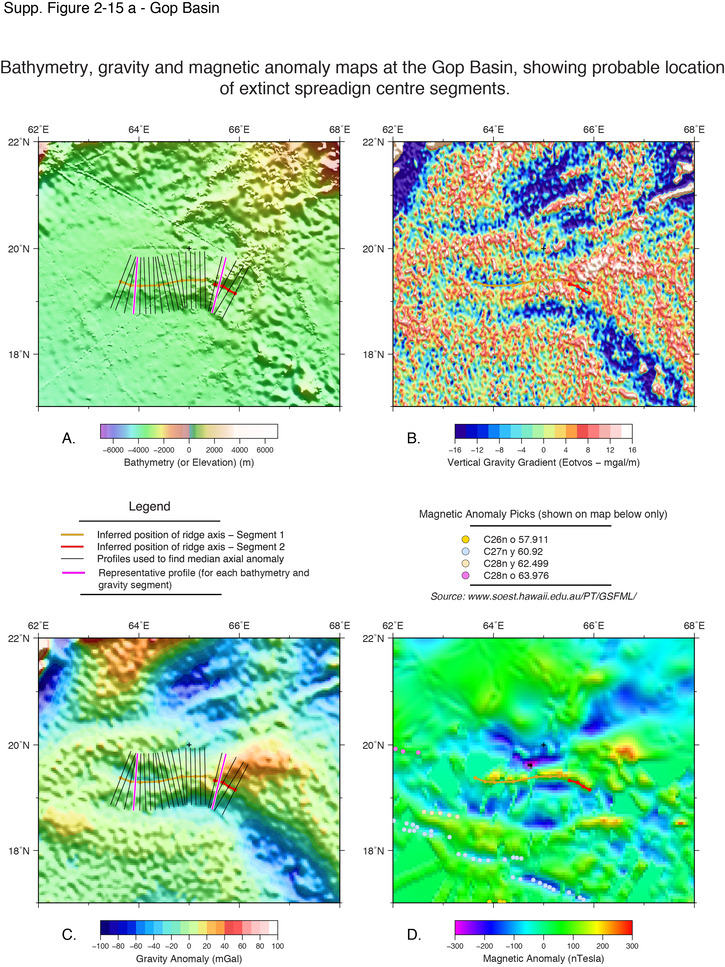| Ocean: | Indian |
| Spreading center type: | Large-scale MOR |
| Time of cessation: | Ca. 56 Ma, chron C25r (Yatheesh et al., 2009) |
| Subsequent active spreading center: | Carlsberg Ridge |
The Gop Basin is an approximately east-west oriented sub-basin in the north of the Arabian Sea. The basin is thought to be underlain by oceanic crust and several studies have presented interpretations of the magnetic anomaly sequence within the basin (Yatheesh et al., 2009; Collier et al., 2008).
A detailed study by Yatheesh et al., 2009 reported two possible models to fit the magnetic anomaly sequence within the Gop Basin. They proposed sequence C29r to C25r of C31r to C25r dependening on the spreading rates used to model to the synthetic sequence. Collier et al., (2008) instead inferred an earlier formation time and argued the ridge ceased at either chron C28r, C29r or C31r.
Bhattacharya and Yatheesh (2015) argue that the Gop ridge was linked to the Laxmi Basin spreading centre and a third spreading arm that trended east into a continental rift on the Indian block at the Narmada Rift as previously suggested by Malod et al., 1997.
At the time that the Gop Rift ceased the Carlsberg Ridge had initiated to the south (Rodriquez et al., 2016) and it is likely that it was not tenable for dual rifts to continue in this region.
The Gop Basin extinct spreading center does not share the characteristic geophysical signal of many well-defined extinct ridges. It is difficult to isolate the location of spreading segments and no prominent negative gravity anomaly is evident. It is possible that the relatively brief period of activity on the ridge (thought to be less than 15 Myr), influences the axial structure and development of the the oceanic lithosphere underneath the ocean floor.
Bhattacharya, G. C., Chaubey, A. K., Murty, G. P. S., Srinivas, K., Sarma, K.V.L.N.S., Subrahmanyam, V. and Krishna, K. S., 1994. Evidence for seafloor spreading in the Laxmi Basin, northeastern Arabian Sea. Earth and Planetary Science Letters, 125, pp. 211-220.
Bhattacharya, G. C. and Yatheesh, V. (2015). Plate-tectonic evolution of the deep ocean basins adjoining the western continental margin of India - A proposed model for the early opening scenario. In Mukherjee, S., ed., Petroleum Geosciences: Indian Contexts, Springer Geology, doi: 10.1007/978-3-319-03119-4_1.
Malod, J. A., Droz, L., Mustafa Kemal, B and Patriat, P., (1997). Early sprading and continental basement transition beneath the Indus deep-sea fan: northeastern Arabian Sea. Marine Geology, 141, pp. 221-225.
Rodriquez, M., Huchon, P., Chamot-Rooke, N., Fournier, M., Delescluse, M., and Francois, T., 2016. Tracking the Paleogene India-Arabia plate boundary. Marine and Petroleum Geology, 72, pp. 336-358.
Yatheesh, V., Bhattacharya, G. C. and Dyment, J., 2009. Early oceanic opening off Western India–Pakistan margin: The Gop Basin revisited. Earth and Planetary Science Letters, 284, pp. 399-408.


